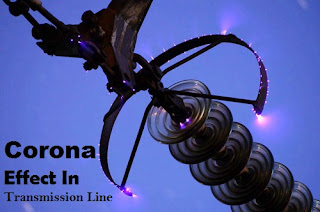Corona
When alternating potential difference is applied
across two conductors whose spacing is large as compared to their diameters,
there is no apparent change in the condition of atmospheric air surrounding the
wires if applied voltage is low. However, when the applied voltage exceeds a
certain value, called critical disruptive voltage, the conductors are
surrounded by a faint violet called corona.
The phenomenon of corona is accompanied by a hissing
sound, production of ozone, power loss and radio interference. The higher the
voltage is raised, the larger and higher the luminous envelope becomes, and
greater are the sound, the power loss and the radio noise. If the applied
voltage is increased to breakdown value, a flash-over will occur between the
conductors due to the breakdown of air insulation.
The phenomenon of violet glow, hissing noise and
production of ozone gas in an overhead transmission line to know as corona.
If the conductors are polished and smooth, the
corona glow will be uniform throughout the length of the conductors otherwise
the rough points will appear brighter. With DC voltage, there is difference in
the appearance of the two wires. The positive wire has uniform glow about it,
while the negative conductor has spotty glow.
Theory of corona formation. Some ionization is
always present in air due to cosmic rays, ultra violet radiation and
radioactivity. Therefore, under normal conditions, the air around the
conductors contains some ionized particles and neutral molecules. When p.d. is
applied between the conductors, potential gradient is set up in the air which
will have maximum value at the conductor surfaces. Under the influence of potential
gradient, the existing free electrons acquire greater velocities. The greater
the applied voltage, the greater the potential gradient and more is the
velocity of free electrons.
When the potential gradient at the conductor surface
reaches above 30kv per cm, the velocity acquired by the free electrons is
sufficient to strike a neutral molecule with enough force to dislodge one or
more electrons from it. This produces another ion and one or more free
electrons, which is turn are accelerated until they collide with other neutral
molecules, thus producing other ions. Thus, the process of ionization is
cumulative. The result of this ionization is that either corona is formed or
spark takes place between the conductors.
The phenomenon of corona is affected by the physical
state of the atmosphere as well as by the conditions of the line. The following
are the factors upon which corona depends.
1. Atmosphere: As corona is formed due to ionsiation of air surrounding the conductors,
therefore, it is affected by the physical state of atmosphere. In the stormy
weather, the number of ions is more than normal and as such corona occurs at
much less voltage as compared with fair weather.
2. Conductor
size: The corona effect depends upon the shape and condition of the conductors.
The rough and irregular surface will give rise to more corona because
unevenness of the surface decreases the value of breakdown voltage. Thus a
stranded conductor has irregular surface and hence gives rise to more coronathat a solid conductor.
3. Spacing
between conductors: If the spacing between the conductors is made very large as
compared to their diameters, there not be any corona effect. It is because
large distance between conductors reduce the electro static stresses at the
conductor surface, thus avoiding corona formation.
4. Live
voltage: The line voltage greatly affects corona. If it is low, there is no
change in the condition of air surrounding the conductors and hence no corona
is formed. However, if the line voltage has such value that electrostatic
stresses developed at the conductor surface make the air around the conductor
conducing, then corona is formed.
Advantages
and Disadvantages of Corona
Advantages
1. Due
to corona formation, the air surrounding the conductor becomes conducting and
hence virtual diameter of the conductor is increased. The increased diameter
reduces the electrostatic stresses between the conductors.
2. Corona
reduces the effects of transients produced by surges.
Disadvantages
1. Corona
is accompanied by a loss of energy. This affects the transmission efficiency of
the line.
2. Ozone
is produced by corona and may cause corrosion of the conductor due to chemical
action.
3. The
current drawn by the line due to corona is non-sinusoidal and hence
non-sinusoidal voltage drop occurs in the line. This may cause inductive
interference with neighbouring communication lines.
Methods
of Reducing Corona Effect
In has been seen that intense corona effects are
observed at a working voltage of 33 kv or above. Therefore, careful design
should be made to avoid corona on the sub-stations or bus-bars rated for 33 kv and
higher voltages otherwise highly ionized air may cause flash-over in the
insulators or between the phases, causing considerable damage to the equipment.
The corona effects can be reduced by the following methods;
1. By
increasing conductor size. By increasing size, the voltage at which corona
occurs is raised and hence corona effects are considerably reduced. This is one
of the reasons that ACSR conductors which have a large cross-sectional area are
used in transmission lines.
2. By
increasing conductor spacing. By increasing the spacing between conductors, the
voltage at which corona occurs is raised and hence corona effects can be
eliminated. However, spacing cannot be increased too much otherwise the cost of
supporting structure may increase to a considerable extent.







0 Comments